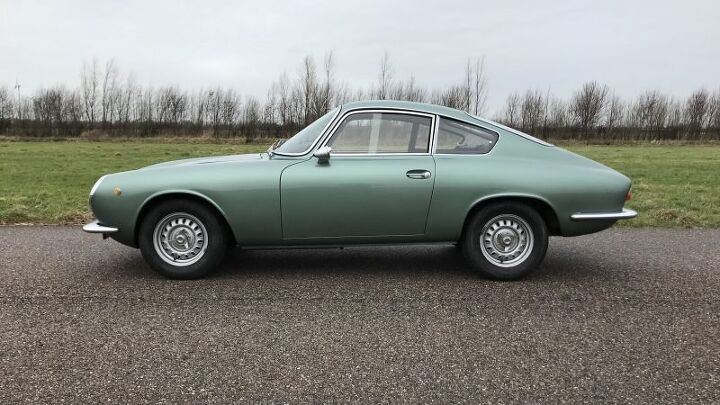Rare Rides: An Elegant 1966 ASA 411 Berlinetta, Founded by Ferrari

A short-lived Italian experiment, the ASA brand was created by Enzo Ferrari himself. Think of it as a stylish Sixties Scion, if you will.
ASA didn’t begin with a brand idea, but rather a singular concept car. Ferrari wanted to serve up offerings to some less well-heeled clientele, and commissioned an alternative to its expensive, flashy GTs. The first inklings of the idea panned out in the Fifties, with Project 854. That test car was a four-cylinder, built on a Fiat 1100 chassis. After the initial test car served as Enzo’s personal vehicle for a while, it was time for something more serious.
The coupe which became an ASA was designed by Giugiaro at Bertone and given the name Mille. It made its debut in Geneva in late 1961. Enzo Ferrari wanted the coupe in production, but after seeing it in the flesh believed the Mille’s compact dimensions didn’t suit the Ferrari name. Other issues included a lack of production capacity at the Ferrari factory. Enzo refused to alter the company’s main factory for this cheap $2,600 car, so it was time for a bit of outsourcing and a rebrand.
Ferrari called close personal friend Oronzio de Nora, who owned the De Nora Electrochemical Group. Forming a new company, ASA, the coupe was built in Milan by employees of the new firm. ASA hosted some racing drivers on its payroll, as well as engineer Giotto Bizzarrini. He developed the tubular space frame of the production car and based the frame design on the 250 GTO.
Establishing the new brand and starting production was a slow process, dragging on for over two years. Engineers kept busy with development in the meantime, and ASA’s 1000 GT rolled out of the factory in 1964. The production car was very true to the concept, using a 1.0-liter inline-four fitted with a couple of carbs. This tiny engine made 91 horses, which was a better power/displacement ratio than the new 275 GTB. Suspension was double wishbone at the front, live axle at the rear, and the anti-roll bar and disc brakes were standard. 60 miles an hour arrived in a rapid 14 seconds.
By the time it went on sale, the ASA’s price was closer to $6,000 in the US. Priced up against Corvettes at $4,500, American sales were understandably slow. Dealers were forced to cut prices to move metal.
Meanwhile, things were busy at the ASA factory as racing models were developed. Enter the 411. Created as a competition version of the 1000 GT, the 411 Berlinetta was introduced in Paris in 1965. Emphasizing lightness and power, the 411 was made out of aluminum instead of the steel-aluminum mix of the standard car. As glass was too heavy, plexiglass was used in all the windows. This shaved 158 pounds off the already light 1,720-pound standard car. Engine displacement was also enlarged, bored up to 1.1 liters. Power jumped to 104 horses, and the 411 was ready to race. Two examples entered the Targa Florio in 1965, placing third and fourth in their class. But that didn’t pay the bills.
The 1000 GT remained in production through 1967, and ASA continued as a dwindling commercial enterprise through 1969 before finally shutting its doors.
Much more rare than the 1000, the 411’s production figures totaled four. Of those, three were used for racing, while a sole example was prepared as a standard road car. This mist green coupe is that car. Yours for $389,000, which isn’t bad for a one-off Ferrari.
[Images: seller]

Interested in lots of cars and their various historical contexts. Started writing articles for TTAC in late 2016, when my first posts were QOTDs. From there I started a few new series like Rare Rides, Buy/Drive/Burn, Abandoned History, and most recently Rare Rides Icons. Operating from a home base in Cincinnati, Ohio, a relative auto journalist dead zone. Many of my articles are prompted by something I'll see on social media that sparks my interest and causes me to research. Finding articles and information from the early days of the internet and beyond that covers the little details lost to time: trim packages, color and wheel choices, interior fabrics. Beyond those, I'm fascinated by automotive industry experiments, both failures and successes. Lately I've taken an interest in AI, and generating "what if" type images for car models long dead. Reincarnating a modern Toyota Paseo, Lincoln Mark IX, or Isuzu Trooper through a text prompt is fun. Fun to post them on Twitter too, and watch people overreact. To that end, the social media I use most is Twitter, @CoreyLewis86. I also contribute pieces for Forbes Wheels and Forbes Home.
More by Corey Lewis
Latest Car Reviews
Read moreLatest Product Reviews
Read moreRecent Comments
- Yuda I'd love to see what Hennessy does with this one GAWD
- Lorenzo I just noticed the 1954 Ford Customline V8 has the same exterior dimensions, but better legroom, shoulder room, hip room, a V8 engine, and a trunk lid. It sold, with Fordomatic, for $21,500, inflation adjusted.
- Lorenzo They won't be sold just in Beverly Hills - there's a Nieman-Marcus in nearly every big city. When they're finally junked, the transfer case will be first to be salvaged, since it'll be unused.
- Ltcmgm78 Just what we need to do: add more EVs that require a charging station! We own a Volt. We charge at home. We bought the Volt off-lease. We're retired and can do all our daily errands without burning any gasoline. For us this works, but we no longer have a work commute.
- Michael S6 Given the choice between the Hornet R/T and the Alfa, I'd pick an Uber.







































Comments
Join the conversation
Beautiful! How about finding a red Barchetta, in honor of the incomparable Neil Peart?!
Interesting they didn't flush mount the fuel cap. That'd be my only quibble with the car. Thanks for doing this one up, Corey!